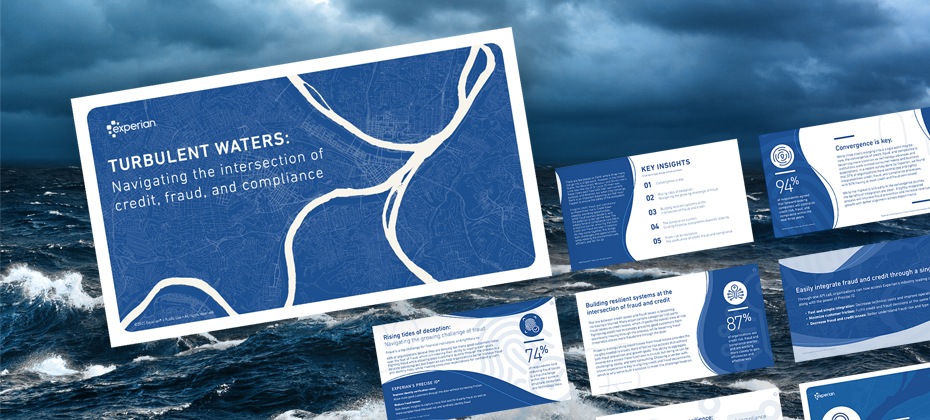Tag: compliance

The days of managing credit risk, fraud prevention, and compliance in silos are over. As fraud threats evolve, regulatory scrutiny increases, and economic uncertainty persists, businesses need a more unified risk strategy to stay ahead. Our latest e-book, Navigating the intersection of credit, fraud, and compliance, explores why 94% of forward-looking companies expect credit, fraud, and compliance to converge within the next three years — and what that means for your business.1 Key insights include: The line between fraud and credit risk is blurring. Many organizations classify first-party fraud losses as credit losses, distorting the true risk picture. Fear of fraud is costing businesses growth. 68% of organizations say they’re denying too many good customers due to fraud concerns. A unified approach is the future. Integrating risk decisioning across credit, fraud, and compliance leads to stronger fraud detection, smarter credit risk assessments, and improved compliance. Read the full e-book to explore how an integrated risk approach can protect your business and fuel growth. Download e-book 1Research conducted by InsightAvenue on behalf of Experian

At Experian, we believe in fostering innovation and collaboration to solve complex challenges. Recently, Ivan Ahmed, one of our talented product management leaders at Experian Housing, had the opportunity to participate in the FHFA 2024 TechSprint, where his team won the award for the best Risk Management and Compliance idea. In this article, we share Ivan's experience as he reflects on the TechSprint, the inspiration behind his team's project, and the valuable lessons learned. Can you share your experience participating in the FHFA 2024 TechSprint? What was the atmosphere like, and how did it feel to be recognized for the best Risk Management and Compliance idea? Let me start by explaining what a TechSprint is. It is a fast-paced, high-energy collaborative workshop where diverse experts and stakeholders come together to design technological solutions to complex problems. Each team is given a high-level problem and use case. From there, stakeholders and domain experts must develop a proof of concept within 3 days to best address the problem. On the last and final day, called the “Demo Day,” teams must showcase their solution in front of a panel of judges. It’s a fun, high-energy, challenging, and rewarding experience. A TechSprint is a convergence of everything I love – technology, business, and design and I think FHFA did a wonderful job orchestrating the event. Each team consisted of representatives from different functions in the housing ecosystem, including lenders, technologists, product managers, and regulators. We were given access to a room, whiteboards, and, most importantly, delicious snacks. We were also given access to industry subject matter experts outside our teams, including representatives from Fannie Mae and Freddie Mac, FHFA, and leaders from top companies. What I found the most impactful was the ability to pressure test our ideas and solutions against these industry subject matter experts. Ideating in a vacuum can be challenging, so being able to stress test things rapidly with these experts allowed us to change course quickly as new information was introduced. Winning the best Risk Management and Compliance idea award was rewarding, especially as we were able to ideate a solution to such a critical accessibility issue. Ultimately, our goal was to help create a fairer, more equitable, and inclusive housing finance system. A big shoutout to my teammates, Wemimo Abbey, Joseph Karbowski, Will Regenauer, and Eddy Atkins. What inspired Team Arsenal to focus on identifying potential gaps in ADA compliance within multifamily buildings, and what were some of the key challenges your team faced during the process? My mother has suffered from several disabilities most of her life. With age, she has become more wheelchair-dependent, and traveling has become a major challenge. On a recent family trip, the entry to our hotel building wasn’t ADA-compliant, and I had to carry her up a flight of stairs. It was frustrating to deal with. I later went down a rabbit hole around ADA compliance and, much to my surprise, learned that only 0.15% of all homes in the U.S. are wheelchair accessible! As we explored the problem space further as a team, we learned how difficult it is to ensure that new and existing rental homes are ADA-compliant. We hypothesized that a solution is needed to establish incentives for borrowers, lenders, and GSEs to meet compliance. A technological solution could more easily enable multi-family lenders and builders to identify rental units that are non-ADA compliant and could provide ways to address the gaps. We noticed two primary challenges: an enforcement gap and an incentive gap. We learned that agency loans (Fannie Mae and Freddie Mac) account for most multi-family home loan originations. If we could tackle the enforcement challenge at the GSE level, we could set up the proper incentives for all players in the multi-family lending process. By providing tools to both the borrower and the GSE’s, we could help foster a more inclusive and accessible rental housing market. How do you envision your AI-driven solution impacting the rental housing market and improving ADA compliance for multifamily buildings? We wanted to ensure that we leveraged the true power of Generative AI, which meant that our solution could take multimodal inputs and produce multimodal outputs. For example, we could train the Generative AI model on photos of interior multi-family rental units and structured or unstructured text like building sketches, site layouts, and local building codes. We could then incorporate ADA design requirements and analyze discrepancies. The result would be a compliance report or tool outlining the adherence level to ADA design requirements and providing tips and recommendations on remediation. The solution could be delivered as a free tool by the GSEs, who could incentivize its usage by offering price concessions to borrowers. Developers could also use the tool to evaluate whether new or existing builds were ADA-compliant. How did your background and experience with Experian contribute to developing your team's winning idea at the FHFA TechSprint? Much of my role at Experian has involved exploring ways to leverage proprietary and public record property data for marketing, account review, and analytical use cases. I work very closely with property data at Experian, so I was very familiar with the types of input fields of property data that would be the most relevant to improving a generative AI model output. Specifically, in our use case, we wanted to train the model to better identify homes and features that were non-compliant with ADA and provide clear remediation steps. We knew that public record property information was available from various sources and could be leveraged as additional third-party input data to improve our model accuracy. What advice would you give to other teams or individuals looking to participate in future TechSprint events, especially those aiming to tackle complex issues like risk management and compliance? It’s important to remember that an ideal solution is both impactful and practical. Practicality is achieved when the solution has both business and technical viability. Therefore, it’s crucial to carefully vet problems and solutions by understanding their viability. Working as a team to solve the problem means leveraging the expertise of subject matter experts around you. Each team member should draw on their strengths, making the collective effort stronger than individual contribution. Most importantly, fairness, inclusivity, and accessibility matter. An effective solution should strive to have a positive social impact in addition to other considerations. Winning with purpose Ivan’s journey through the FHFA 2024 TechSprint exemplifies the innovative and collaborative spirit that drives our team at Experian. His reflections highlight the impact of well-designed technological solutions on critical issues like ADA-compliance in multifamily housing. We hope Ivan’s experience inspires others to explore their potential in solving complex problems and to participate in future TechSprints, where innovative thinking and a commitment to social good can lead to meaningful change.

In this article...What is fair lending?Understanding machine learning modelsThe pitfalls: bias and fairness in ML modelsFairness metricsRegulatory frameworks and complianceHow Experian® can help As the financial sector continues to embrace technological innovations, machine learning models are becoming indispensable tools for credit decisioning. These models offer enhanced efficiency and predictive power, but they also introduce new challenges. These challenges particularly concern fairness and bias, as complex machine learning models can be difficult to explain. Understanding how to ensure fair lending practices while leveraging machine learning models is crucial for organizations committed to ethical and compliant operations. What is fair lending? Fair lending is a cornerstone of ethical financial practices, prohibiting discrimination based on race, color, national origin, religion, sex, familial status, age, disability, or public assistance status during the lending process. This principle is enshrined in regulations such as the Equal Credit Opportunity Act (ECOA) and the Fair Housing Act (FHA). Overall, fair lending is essential for promoting economic opportunity, preventing discrimination, and fostering financial inclusion. Key components of fair lending include: Equal treatment: Lenders must treat all applicants fairly and consistently throughout the lending process, regardless of their personal characteristics. This means evaluating applicants based on their creditworthiness and financial qualifications rather than discriminatory factors. Non-discrimination: Lenders are prohibited from discriminating against individuals or businesses on the basis of race, color, religion, national origin, sex, marital status, age, or other protected characteristics. Discriminatory practices include redlining (denying credit to applicants based on their location) and steering (channeling applicants into less favorable loan products based on discriminatory factors). Fair credit practices: Lenders must adhere to fair and transparent credit practices, such as providing clear information about loan terms and conditions, offering reasonable interest rates, and ensuring that borrowers have the ability to repay their loans. Compliance: Financial institutions are required to comply with fair lending laws and regulations, which are enforced by government agencies such as the Consumer Financial Protection Bureau (CFPB) in the United States. Compliance efforts include conducting fair lending risk assessments, monitoring lending practices for potential discrimination, and implementing policies and procedures to prevent unfair treatment. Model governance: Financial institutions should establish robust governance frameworks to oversee the development, implementation and monitoring of lending models and algorithms. This includes ensuring that models are fair, transparent, and free from biases that could lead to discriminatory outcomes. Data integrity and privacy: Lenders must ensure the accuracy, completeness, and integrity of the data used in lending decisions, including traditional credit and alternative credit data. They should also uphold borrowers’ privacy rights and adhere to data protection regulations when collecting, storing, and using personal information. Understanding machine learning models and their application in lending Machine learning in lending has revolutionized how financial institutions assess creditworthiness and manage risk. By analyzing vast amounts of data, machine learning models can identify patterns and trends that traditional methods might overlook, thereby enabling more accurate and efficient lending decisions. However, with these advancements come new challenges, particularly in the realms of model risk management and financial regulatory compliance. The complexity of machine learning models requires rigorous evaluation to ensure fair lending. Let’s explore why. The pitfalls: bias and fairness in machine learning lending models Despite their advantages, machine learning models can inadvertently introduce or perpetuate biases, especially when trained on historical data that reflects past prejudices. One of the primary concerns with machine learning models is their potential lack of transparency, often referred to as the "black box" problem. Model explainability aims to address this by providing clear and understandable explanations of how models make decisions. This transparency is crucial for building trust with consumers and regulators and for ensuring that lending practices are fair and non-discriminatory. Fairness metrics Key metrics used to evaluate fairness in models can include standardized mean difference (SMD), information value (IV), and disparate impact (DI). Each of these metrics offers insights into potential biases but also has limitations. Standardized mean difference (SMD). SMD quantifies the difference between two groups' score averages, divided by the pooled standard deviation. However, this metric may not fully capture the nuances of fairness when used in isolation. Information value (IV). IV compares distributions between control and protected groups across score bins. While useful, IV can sometimes mask deeper biases present in the data. Disparate impact (DI). DI, or the adverse impact ratio (AIR), measures the ratio of approval rates between protected and control classes. Although DI is widely used, it can oversimplify the complex interplay of factors influencing credit decisions. Regulatory frameworks and compliance in fair lending Ensuring compliance with fair lending regulations involves more than just implementing fairness metrics. It requires a comprehensive end-to-end approach, including regular audits, transparent reporting, and continuous monitoring and governance of machine learning models. Financial institutions must be vigilant in aligning their practices with regulatory standards to avoid legal repercussions and maintain ethical standards. Read more: Journey of a machine learning model How Experian® can help By remaining committed to regulatory compliance and fair lending practices, organizations can balance technological advancements with ethical responsibility. Partnering with Experian gives organizations a unique advantage in the rapidly evolving landscape of AI and machine learning in lending. As an industry leader, Experian offers state-of-the-art analytics and machine learning solutions that are designed to drive efficiency and accuracy in lending decisions while ensuring compliance with regulatory standards. Our expertise in model risk management and machine learning model governance empowers lenders to deploy robust and transparent models, mitigating potential biases and aligning with fair lending practices. When it comes to machine learning model explainability, Experian’s clear and proven methodology assesses the relative contribution and level of influence of each variable to the overall score — enabling organizations to demonstrate transparency and fair treatment to auditors, regulators, and customers. Interested in learning more about ensuring fair lending practices in your machine learning models? Learn More This article includes content created by an AI language model and is intended to provide general information.

In a financial world that's increasingly connected and complex, monitoring transactions is not just good business practice — it's a regulatory necessity. Anti-money laundering (AML) transaction monitoring stands as a crucial barrier against financial crimes, which ensures the integrity of financial systems worldwide. For financial institutions, the challenges of AML compliance and the tools to meet them continue to evolve. In this blog post, we'll walk through the basics, best practices, and future of AML transaction monitoring. What is AML transaction monitoring? AML transaction monitoring refers to the systems and processes financial institutions use to detect and report potentially suspicious transactions to the Financial Crimes Enforcement Network (FinCEN) under the United States Department of Treasury, which spearheads the efforts to track financial crimes — money laundering and financing of criminal or terrorist activities. By continuously monitoring customer transactions and establishing patterns of behavior, suspicious activities can be identified for further investigation. The role of AML transaction monitoring AML transaction monitoring identifies potential criminal activities and helps maintain a clean and efficient financial ecosystem. By being proactive in preventing the misuse of services, organizations can protect their reputation, strengthen customer trust, and uphold regulatory requirements. The challenge of false positives However, AML compliance is not without challenges. The systems in place often produce many 'false positives', transactions identified as potentially suspicious that, after investigation, turn out to be mundane. These false alarms can overwhelm compliance departments, leading to inefficiency and potentially missing real red flags. Why is AML transaction monitoring important? Understanding the importance of AML transaction monitoring requires a broader look at the implications of financial crimes. Money laundering often supports other serious crimes such as drug trafficking, fraud, and even terrorism. The ability to interrupt the flow of illicit funds also disrupts these additional criminal networks. Furthermore, for organizations, the cost of non-compliance can be substantial — financially and reputationally. Penalties for inadequate AML controls can be hefty, signaling the need for robust monitoring systems. Specifics on compliance Compliance with AML regulations is not a choice but a must. Financial institutions are required to comply with AML laws and regulations to protect their businesses and the industry as a whole. This includes understanding and adhering to regulation changes, which can be complex and have significant operational impacts. How does AML transaction monitoring work? There are two main approaches to transaction monitoring: Rule-based systems: These rely on pre-defined rules that flag transactions exceeding certain thresholds, originating from high-risk countries, or involving specific types of activities. Scenario-based systems: These use more sophisticated algorithms to analyze transaction patterns and identify anomalies that might not be captured by simple rules. This can include analyzing customer behavior, source of funds, and the purpose of transactions. Most organizations use a combination of both approaches. Transaction monitoring software is a valuable tool, but it's important to remember that it's not a foolproof solution. Human analysis is still essential to investigate flagged transactions and determine if they are truly suspicious. Implementing AML transaction monitoring solutions Implementing a robust AML transaction monitoring system requires the right technology and the right strategy. Beyond the software, it's about embedding a culture of compliance within the organization. Choosing the right AML solution The right AML solution should be based on the specific needs of the institution, the complexity of its operations, and the sophistication of the fraud landscape it faces. It's imperative to pick a solution that is agile, scalable, and integrates seamlessly with existing systems. Leveraging KYC and CIP programs Know your customer (KYC) and customer identification program (CIP) are deeply connected to transaction monitoring. Implementing a robust KYC program helps to establish a strong customer identity, whereas a solid CIP ensures that essential customer information is verified at the time of account opening. Automation and AI in AML compliance Automation and AI are revolutionizing AML compliance, especially in transaction monitoring. AI systems, with their ability to learn and evolve, can significantly reduce false positives, making the compliance process more efficient and effective. Advanced AML solutions and the future Technological advancements are constantly reshaping the AML landscape, including solutions incorporating big data analysis and machine learning. Utilizing big data for better insights: Big data analytics provides an unprecedented ability to spot potential money laundering by analyzing vast amounts of transactional data, allowing for better contextual understanding and the ability to identify patterns of suspicious activity. Machine learning and predictive analytics: Machine learning technologies have the potential to refine transaction monitoring by continuously learning new behaviors and adapting to evolving threats. Predictive analytics can help in identifying potential risks well in advance and taking pre-emptive actions. The human element in AML Despite the advancing technology, the human element remains crucial. AML systems are only as good as the people who operate them. Organizations must invest in: Continuous training and skill development: Continuous training ensures that employees remain updated on regulations, compliance techniques, and the latest tools. Developing a team with AML expertise is an investment in the institution's security and success. Cultivating a compliance culture: Cultivating a corporate culture that values compliance is vital. From the highest levels of management to front-line staff, a mindset that embraces the duty to protect against financial crime is a powerful asset in maintaining an effective AML program. How we can help As a leader in fraud prevention and identity verification, Experian’s AML solutions can help you increase the effectiveness of your AML program to efficiently comply with federal and international AML regulations while safeguarding your organization from financial crime. We provide data, models, and automated systems and processes to monitor, detect, investigate, document and report potential money laundering activities across the entire customer lifecycle. Learn more about Experian’s AML solutions *This article includes content created by an AI language model and is intended to provide general information.

Know Your Customer (KYC) procedures are a requirement for banks and other financial institutions to collect and verify the identity of their customers. When a bank verifies the identity of another organization or its owners, the process may be called Know Your Business (KYB) instead. As part of banks’ anti-money laundering (AML) programs, KYC can help stop corruption, money laundering and terrorist financing. Creating and maintaining KYC programs is also important for regulatory compliance, reputation management and fraud prevention. READ: How to Build a Know Your Customer Checklist – Everything You Need to Know The three components of KYC programs Banks can largely determine how to set up their KYC and AML programs within the applicable regulatory guidelines. In the United States, KYC needs to happen when banks initially onboard a new customer. But it’s not a one-and-done event—ongoing customer and transaction monitoring is also important. Customer Identification Program (CIP) Creating a robust Customer Identification Program (CIP) is an essential part of KYC. At a minimum, a bank’s CIP requires it to collect the following information from new customers: Name Date of birth Address Identification number, such as a Social Security number (SSN) or Employer Identification Number (EIN) Banks' CIPs also have to use risk-based procedures to verify customers’ identities and form a reasonable belief that they know the customer's true identity.1 This might involve comparing the information from the application to the customer’s government-issued ID, other identifying documents and authoritative data sources, such as credit bureau databases. Additionally, the bank's CIP will govern how the bank: Retains the customer’s identifying information Compares customer to government lists Provides customers with adequate notices Banks can create CIPs that meet all the requirements in various ways, and many use third-party solutions to quickly collect data, detect forged or falsified documents and verify the provided information. INFOGRAPHIC: Streamlining the Digital Onboarding Process: Beating Fraud at its Game Customer due diligence (CDD) CIP and CDD overlap, but the CIP primarily verifies a customer’s identity while customer due diligence (CDD) helps banks understand the risk that each customer poses. To do this, banks try to understand what various types of customers do, what those customers’ normal banking activity looks like, and in contrast, what could be unusual or suspicious activity. Financial institutions can use risk ratings and scores to evaluate customers and then use simplified, standard or enhanced due diligence (EDD) processes based on the results. For example, customers who might pose a greater risk of laundering money or financing terrorism may need to undergo additional screenings and clarify the source of their funds. Ongoing monitoring Ongoing or continuous monitoring of customers’ identities and transactions is also important for staying compliant with AML regulations and stopping fraud. The monitoring can help banks spot a significant change in the identity of the customer, beneficial owner or account, which may require a new KYC check. Unusual transactions can also be a sign of money laundering or fraud, and they may require the bank to file a suspicious activity report (SAR). Why is KYC important in banking? Understanding and implementing KYC processes can be important for several reasons: Regulatory compliance: Although the specific laws and rules can vary by country or region, many banks are required to have AML procedures, including KYC. The fines for violating AML regulations can be in the hundreds of millions— a few banks have been fined over $1 billion for lax AML enforcement and sanctions breaching. Reputation management: In some cases, enforcement actions and fines were headline news. Banks that don’t have robust KYC procedures in place risk losing their customers' trust and respect. Fraud prevention: In addition to the regulatory requirements, KYC policies and systems can also work alongside fraud management solutions for banks. Identity verification at onboarding can help banks identify synthetic identities attempting to open money mule accounts or take out loans. Ongoing monitoring can also be important for identifying long-term fraud schemes and large fraud rings. ON-DEMAND WEBINAR: Fraud Strategies for a Positive Customer Experience KYC in a digital-first world Many financial institutions have been going through digital transformations. Part of that journey is updating the systems and tools in place to meet the expectations of customers and regulators. An Experian survey found that about half of consumers (51 percent) consider abandoning the creation of a new account because of friction or a less-than-positive experience — that increased to 69 percent for high-income households.2 The survey wasn’t specific to financial services, but friction could be a problem for banks wanting to attract new account holders. Just as access to additional data sources and machine learning help automate underwriting, financial institutions can use technological advances to add an appropriate amount of friction based on various risk signals. Some of these can be run in the background, such as an electronic Consent Based Social Security Number Verification (eCBSV) check to verify the customer’s name, SSN and date of birth match the Social Security Administration’s records. Others may require more customer involvement, such as taking a selfie that’s then compared to the image on their photo ID — Experian CrossCore® Doc Capture enables this type of verification. Experian is a leader in identity and data management Experian's identity verification solutions use proprietary and third-party data to help banks manage their KYC procedures, including identity verification and Customer Identification Programs. By bundling identity verification with fraud assessment, banks can stop fraudsters while quickly resolving identity discrepancies. The automated processes also allow you to offer a low-friction identity verification experience and use step-up authentications as needed. Learn more about Experian’s identity solutions. 1FDIC (2021). Customer Identification Program 2Experian (2023). Experian's 2023 Identity and Fraud Report

This article was updated on January 31, 2024. Debt. For many, it’s a struggle – and a constant one. In fact, total consumer debt balances have increased year-over-year.1 High inflation and fears of a recession aren't letting up either. Successful third-party debt collections can be achieved by investing in the right data and technologies. Overcoming debt collections challenges While third-party debt collectors may take a more specialized approach to collections, they face unique challenges. Debt collectors must find the debtor, get them to respond, collect payment, and stay compliant. With streamlined processes and enhanced strategies, lending institutions and collection agencies can recoup more costs. Embrace automationAutomation, artificial intelligence, and machine learning are at the forefront of the continued digital transformation within the world of collections. When implemented well, automation can ease pressure on call center agents and improve the customer experience. Automated systems can also help increase recovery rates while minimizing the risk of human error and the corresponding liability. READ: Three Tips for Successful Automated Debt CollectionsMaximize digitalizationIntegrating and expanding digital technologies is mandatory to be successful in the third-party debt collections space. Third-party debt collectors must be at the forefront of adopting digital communication tools (i.e., email, text, chatbots, and banking apps), to connect more easily with debtors and provide a frictionless customer experience. A digital debt recovery solution helps third-party debt collectors streamline processes, maintain debt collection compliance, and maximize collections efforts. READ: The Ultimate Guide to Successful Debt Collection TechniquesLeverage the best data Consumer data is ever-changing, especially during times of economic distress. Capturing accurate consumer information through a combination of data sources — and continually evaluating the data’s validity — is key to reducing risk throughout the consumer life cycle. By gaining a fresher, more complete view of existing and potential customers, third-party debt collectors can better determine an individual’s propensity to pay and enhance their overall decisioning. Keep pace with changing regulations With increasing scrutiny on the financial services industry and ever-evolving consumer protection and privacy regulations, remaining compliant is a top priority for third-party debt collections departments and agencies. The increased focus on regulations and compliance has also brought to the surface the need for teams to include debt collectors with soft skills who can communicate effectively with indebted consumers. With the right processes and third-party debt collections tools, you can better develop a robust compliance management strategy that works to prevent reputational risk and minimize costly violations. Finding the right debt collections partner In today's climate, it's never been more important to build the right third-party debt collections strategies for your business. By creating a more effective, consumer-focused collections process, you can maximize your recovery efforts, make more profitable decisions and focus your resources where they’re needed most. Our third-party debt management solutions empower your organization to see the complete behavioral, demographic, and emerging view of customer portfolios through extensive data assets, debt collection predictive analytics innovative platforms. For more insights to strengthen your debt collection strategy, download our tip sheet. Access tip sheet

The economic volatility of the last several years has left local, state, and even federal budgets tighter than usual, meaning agencies must collect every dollar owed and do it efficiently. So how do agencies continue to deliver the services citizens expect and have given their tax dollars to support? It starts with an efficient, effective collections strategy. The need for collections An important source of revenue for many government agencies is overdue obligations. These might include: Business, personal, and property taxesChild supportFinesCourt fees By collecting on these obligations – and doing so efficiently – agencies can better fund themselves to serve their citizens. Debt collections process While many agencies are, at least initially, responsible for their debt management efforts, there are many layers to the collections process. Step 1: The agency manages the collections process independently (manually or automatically). Step 2: The Bureau of Fiscal Service takes over servicing delinquent debts and work with the debtor to pay it, suspend it, or end collections efforts. Step 3: The debt may be sent to a Private Collection Agency (PCA). Better collections with better data To collect effectively, agencies need to prioritize and streamline debt assessment and collection, which starts with better data. First, better data – like the data provided via skip tracing – enables better management of data surrounding moves, name changes, changes in marital status, and more, all of which makes for better collections efforts. Second is prioritizing collections efforts to focus on those citizens with the best ability to repay, making the most of existing resources and leveraging automated tools where available. Third is keeping collections efforts compliant with all rules and regulations, which is made easier with the right partner. How Experian can help Experian assists organizations of all shapes and sizes to monitor, segment, and prioritize receivable accounts. We leverage timely and relevant information for greater insight into skip tracing, identify the best times for collections efforts, and monitor, measure, test, and refine strategies to maximize results. To learn more about how Experian can help your agency maximize your collections efforts, visit us or request a call. Learn more

Since January 27, 2020, the federal government has been operating under a Public Health Emergency (PHE) related to the COVID-19 pandemic. On January 14, 2022, this PHE was renewed for an eighth time. While we are currently in the midst of the omicron surge, some suggest that we may be nearing the beginning of the end of the pandemic — and thus the inevitable expiration of the PHE. Impacts of the PHE While the PHE remains in effect, states must maintain current Medicaid enrollees, regardless of changes to their eligibility status. A recent report showed Medicaid enrollment increased 16.8% from February 2020 to June 2021. This is counter to the previous trend, where enrollment declined from 2017 to 2019. Furthermore, the average per capita Medicaid cost to states is estimated at $5K–$10K (states share about one-third of the cost of Medicaid). The combination of the per capita expense and the increased number of enrollees during the pandemic translates to a significant impact on state budgets. Once the federal order expires, states will have 12 months to redetermine eligibility for continued enrollment in the program, or risk bearing 100% of the associated cost. Processing redetermination in a timely manner is critical for states to avoid unnecessary expenditures and to ensure that citizens are receiving access to the correct services. It’s imperative that states start planning for redetermination of benefits for continued Medicaid coverage as soon as possible to be prepared to take action at the inevitable conclusion of the PHE. Preparing for redeterminations At the end of the PHE, states will need a system to easily and confidently review their current Medicaid rolls to confirm eligibility. Implementing this system will likely involve working with a trusted partner who can provide tools and advantages such as: Portfolio analysis Real-time analysis Verification of income and employment Compliance adherence Affordability With the correct systems in place, states can act quickly once the PHE ends, saving unnecessary expenditures and providing better services to citizens in need. If your state agency would like to learn more about how Experian can assist with citizen benefit redetermination efforts, visit us or request a call. Learn more

The collections landscape is changing as a result of new and upcoming legislation and increased expectations from consumers. Because of this, businesses are looking to create more effective, consumer-focused collections processes while remaining within regulatory guidelines. Our latest tip sheet has insights that can help businesses and agencies optimize their collections efforts and remain compliant, including: Start with the best data Keep pace with changing regulations Focus on agility Pick the right partner Download the tip sheet to learn how to maximize your collections efforts while reducing costs, avoiding reputational damage and fines, and improving overall engagement. Download tip sheet

The Telephone Consumer Protection Act (TCPA), which regulates telemarketing calls, autodialed calls, prerecorded calls, text messages and unsolicited faxes, was originally passed in 1991. Since that time, there have been many rulings and updates that impact businesses’ ability to maintain TCPA compliance. Recent TCPA Changes On December 30, 2020, the Federal Communications Commission (FCC) updated a number of TCPA exemptions, adding call limits and opt-out requirements, and codifying exemptions for calls to residential lines. These changes, along with other industry changes, have added additional layers of complication to keeping compliant while still optimizing operations and the consumer experience. Maintaining TCPA Compliance Businesses who do not maintain TCPA compliance could be subject to a lawsuit and paying out damages, and potential hits to their reputation. With the right partner in place, businesses can maintain data hygiene and accuracy to increase right-party contact (and reduce wrong-party contact) to keep collections streamlined and improve the customer experience. Using the right technology in place, it’s easier to: Monitor and verify consumer contact information for a better customer experience while remaining compliant. Receive and monitor daily notifications about changes in phone ownership information. Maintain compliance with Regulation F by leveraging a complete and accurate database of consumer information. When searching for a partner, be sure to look for one who offers data scrubbing, phone type indicators, phone number scoring, phone number identity verification, ownership change monitoring, and who has direct access to phone carriers. To learn more about how the right technology can help your business maintain TCPA compliance, visit us or request a call. Learn more

The COVID-19 pandemic has created shifting economic conditions and rapidly evolving consumer preferences. Lenders must keep up by re-evaluating their strategies to accelerate growth and beat the competition. Here's how AI/ML can help your organization evolve post-COVID-19: With the democratization of AI/ML, lenders of all sizes can now use this technology to grow their lending and optimize for strategic growth. Register for our upcoming webinar to see how lenders like Elevate have incorporated this new technology into their business processes. Register now

When running a credit report on a new applicant, you must ensure Fair Credit Reporting Act (FCRA) compliance before accessing, using and sharing the collected data. The Coronavirus Aid, Relief, and Economic Security (CARES) Act has impacted credit reporting under the FCRA, as has new guidance from the Consumer Financial Protection Bureau (CFPB). Recent updates include: The CARES Act amended the FCRA to require furnishers who agree to an “accommodation,”1 to report the account as current, although it is permitted to continue to report the account as delinquent if the account was delinquent before the accommodation was made. Although not legally obligated, data furnishers should continue furnishing information to the credit reporting agencies (CRAs) during the COVID-19 crisis, and make sure that information reported is complete and accurate. Below is a brief FCRA-related compliance overview2 covering various FCRA requirements3 when requesting and using consumer credit reports for an extension of credit permissible purpose. For more information regarding your responsibilities under the FCRA as a user of consumer reports, please consult your Legal Counsel and the Notice to Users of Consumer Reports: Obligations of Users Under the FCRA handbook located on our website. Before obtaining a consumer report you have… Reviewed your federal and state regulations and laws related to consumer reports, scores, decisions, etc. Made sure you have a valid permissible purpose for pulling the consumer report. Certified compliance to the CRA from which you are getting the consumer report. You have certified that you complied with all the federal and state requirements. After you take an adverse action based on a consumer report you… Provide the consumer with an oral, written or electronic notice of the adverse action. Provide written or electronic disclosure of the numerical credit score used to take the adverse action, or when providing a “risk-based pricing” notice. Provide the consumer with an oral, written or electronic notice, which includes the below information: Name, address and telephone number of CRA that supplied the report, if nationwide. A statement that the CRA did not make the adverse decision and therefore can’t explain why the decision was made. Notice of the consumer’s right to a free copy of their report from the CRA, if requested within 60 days. Notice of the consumer’s right to dispute with the CRA the accuracy or completeness of any information in a consumer report provided by the CRA. Provide the consumer with a “risk-based pricing” notice if credit was granted but on less favorable terms based on information in their consumer report. We understand how challenging it is to understand and meet all your obligations as a data furnisher – we’re here to make it a little easier. Click below to speak with a representative and gain more insight on how the CARES Act impacts FCRA reporting. Download overview Speak with a representative 1An “accommodation” is defined as “an agreement to defer one or more payments, make a partial payment, forbear any delinquent amounts, modify a loan or contract, or any other assistance or relief” granted to a consumer affected by COVID-19 during the covered period. 2This FCRA overview is not legal guidance and does not enumerate all your requirements under the FCRA as a user of consumer reports. Additionally, this FCRA Overview is not intended to provide legal advice or counsel you regarding your obligations under the FCRA or any other federal or state law or regulation. Should you have any questions about your institution’s specific obligations under the FCRA or any other federal or state law or regulation, you should consult with your Legal Counsel. 3This FCRA overview is intended to be used solely by financial service providers when extending credit to consumers and does not include all FCRA regulatory obligations. You are responsible for regulatory compliance when requesting and using consumer reports, which includes adhering to all applicable federal and state statutes and regulations and ensuring that you have the correct policies and procedures in place.

This is the final part of a three part series of blog posts highlighting key focus areas for your response to the COVID-19 health crisis: Risk, Operations, Consumer Behavior, and Reporting and Compliance. For more information and the latest resources, please visit Look Ahead 2020, Experian’s COVID-19 resource center with the latest news and tools for our business partners as well as links to consumer resources and a risk simulator. To read the first post, click here. To read the second post, click here. Consumer Behavior Changes Consumers will be hit hard by the economic fallout from the virus. They’ll need to manage available credit and monthly income to bridge the gap when many people are faced with lost wages, tips and the ability to work. Often, the only way to monitor these short-term risks is with trended credit attributes, from both traditional and alternative data sources. These attributes were developed to provide additional insights into how consumer credit usage is trending over time. Is their debt and spending increasing? Have their credit lines been reduced? Have they historically been a transactor but have now started revolving balances? Could the account be a synthetic identity, set up for intentional misuse of credit? The most predictive attributes available in these times can transform how you can identify and respond to risk. Reporting and Compliance The regulatory environment is continuing to shift. There are continuous changes to compliance in the digital space for emerging channels and applications. There will be impacts to credit reporting and processes that may echo the response from other major natural disasters. The good news is that the framework developed for Comprehensive Capital Analysis and Review (CCAR) stress testing can be used to run scenarios and understand impacts. Although bank capital is very strong, additional regulation, such as the Current Expected Credit Losses (CECL), with all the latest shifts around compliance, may continue to increase the pressure on financial institutions. Having an adaptable process to forecast and stress-test scenarios to adjust capital requirements, especially in light of government fiscal and monetary stimulus measures, will be at the core of managing financial stability during a period of changes. Conclusion We need to brace for the pending recession after the longest economic expansion in our lifetimes. These are the times where organizations may struggle to survive or thrive in the face of adversity. This is the time to act on your strategic plan, lean on your strategic partners, and leverage industry leading data and capabilities to soften the landing and thrive in the next phase of growth. Let’s prepare and get through this, together. Learn More

This is the introduction to a series of blog posts highlighting key focus areas for your response to the COVID-19 health crisis: Risk, Operations, Consumer Behavior, and Reporting and Compliance. For more information and the latest resources, please visit Look Ahead 2020, Experian's COVID-19 resource center with the latest news and tools for our business partners as well as links to consumer resources and a risk simulator. Responding to COVID-19 The response to COVID-19 is rolling out across the global financial system and here in North America. Together, we’re adapting to working remotely and adjusting to our “new normal.” It seems the long forecasted economic recession is finally and abruptly on our doorstep. Recession planning has been a focus for many organizations, and it’s now time to act on these contingency plans and respond to the downturn. The immediate effects and those that quickly follow the pandemic will widely impact the economy, affecting businesses of all sizes, employment and consumer confidence. We learned from the housing crisis and Great Recession how to identify and adapt to emerging risks. We can apply those skills while rebuilding the economy and focusing on the consumer. How should you respond? What strategies should you deploy? How can you balance emerging risks, changing consumer expectations and regulatory impacts? First, let's draw upon the best knowledge we gained from the last recession and apply those learnings. Second, we need to understand the current environment including the impact of major changes in technology and consumer behavior over the last few years. This approach will allow us to identify key themes to help build-out strategies to focus resources, respond successfully and deliver for stakeholders. Anticipate the pervasive and highly impactful market dynamics and trends The impact of this downturn on the consumer, on businesses and on financial institutions will be very different to that of the Great Recession. There will be a complete loss of income for many workers and small businesses. In a survey conducted by the Center for Financial Services Innovation (CFSI), more than 112 million Americans said that they don’t have enough savings to cover three months of living expenses*. These volatile market conditions and consumer insecurity will cause changes to your business models. You must prepare to manage increased fraud attacks, continue to push toward digital banking and understand regulatory changes. Learn More *U.S. Financial Health Pulse, 2018 Baseline Survey Results. https://s3.amazonaws.com/cfsi-innovation-files-2018/ wp-content/uploads/2018/11/20213012/Pulse-2018- Baseline-Survey-Results-11-16.18.pdf

To provide consumers with clear-cut protections against disturbance by debt collectors, the Consumer Financial Protection Bureau (CFPB) issued a Notice of Proposed Rulemaking (NPRM) to implement the Fair Debt Collection Practices Act (FDCPA) earlier this year. Among many other things, the proposal would set strict limits on the number of calls debt collectors may place to reach consumers weekly and clarify requirements for consumer-facing debt collection disclosures. A bigger discussion Deliberation of the debt collection proposal was originally scheduled to begin on August 18, 2019. However, to allow commenters to further consider the issues raised in the NPRM and gather data, the comment period was extended by 20 days to September 18, 2019. It is currently still being debated, as many argue that the proposed rule does not account for modern consumer preferences and hinders the free flow of information used to help consumers access credit and services. The Association of Credit and Collection Professionals (ACA International) and US House lawmakers continue to challenge the proposal, stating that it doesn’t ensure that debt collectors’ calls to consumers are warranted, nor does it do enough to protect consumers’ privacy. Many consumer advocates have expressed doubts about how effective the proposed measures will be in protecting debtors from debt collector harassment and see the seven-calls-a-week limit on phone contact as being too high. In fact, it’s difficult to find a group of people in full support of the proposal, despite the CFPB stating that it will help clarify the FDCPA, protect lenders from litigation and bring consumer protection regulation into the 21st century. What does this mean? Although we don’t know when, or if, the proposed rule will go into effect, it’s important to prepare. According to the Federal Register, there are key ways that the new regulation would affect debt collection through the use of newer technologies, required disclosures and limited consumer contact. Not only will the proposed rules apply to debt collectors, but its provisions will also impact creditors and servicers, making it imperative for everyone in the financial services space to keep watch on the regulation’s status and carefully analyze its proposed rules. At Experian, our debt collection solutions automate and moderate dialogues and negotiations between consumers and collectors, making it easier for collection agencies to connect with consumers while staying compliant. Our best-in-class data and analytics will play a key role in helping you reach the right consumer, in the right place, at the right time. Learn more